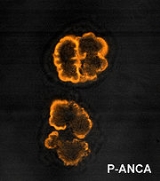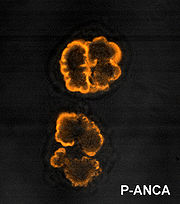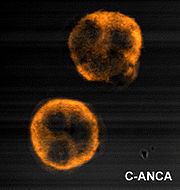
Anti-neutrophil cytoplasmic antibody
Encyclopedia


Antigen
An antigen is a foreign molecule that, when introduced into the body, triggers the production of an antibody by the immune system. The immune system will then kill or neutralize the antigen that is recognized as a foreign and potentially harmful invader. These invaders can be molecules such as...
s in the cytoplasm
Cytoplasm
The cytoplasm is a small gel-like substance residing between the cell membrane holding all the cell's internal sub-structures , except for the nucleus. All the contents of the cells of prokaryote organisms are contained within the cytoplasm...
of neutrophil granulocyte
Neutrophil granulocyte
Neutrophil granulocytes are the most abundant type of white blood cells in mammals and form an essential part of the innate immune system. They are generally referred to as either neutrophils or polymorphonuclear neutrophils , and are subdivided into segmented neutrophils and banded neutrophils...
s (the most common type of white blood cell
White blood cell
White blood cells, or leukocytes , are cells of the immune system involved in defending the body against both infectious disease and foreign materials. Five different and diverse types of leukocytes exist, but they are all produced and derived from a multipotent cell in the bone marrow known as a...
) and monocytes. They are detected as a blood test
Blood test
A blood test is a laboratory analysis performed on a blood sample that is usually extracted from a vein in the arm using a needle, or via fingerprick....
in a number of autoimmune disorders, but are particularly associated with systemic vasculitis
Vasculitis
Vasculitis refers to a heterogeneous group of disorders that are characterized by inflammatory destruction of blood vessels. Both arteries and veins are affected. Lymphangitis is sometimes considered a type of vasculitis...
, so called ANCA-associated vasculitides
ANCA-associated vasculitides
ANCA-associated vasculitides are diseases caused by vasculitis in which antineutrophil cytoplasmic antibodies can be detected in the blood.-Types:Three main AAVs are Churg-Strauss syndrome, microscopic polyangiitis and Wegener's granulomatosis...
.
Types
ANCA were originally shown to divide into two main classes, c-ANCA and p-ANCA, based on the pattern of staining on ethanolEthanol
Ethanol, also called ethyl alcohol, pure alcohol, grain alcohol, or drinking alcohol, is a volatile, flammable, colorless liquid. It is a psychoactive drug and one of the oldest recreational drugs. Best known as the type of alcohol found in alcoholic beverages, it is also used in thermometers, as a...
-fixed neutrophils and the main target antigen
Antigen
An antigen is a foreign molecule that, when introduced into the body, triggers the production of an antibody by the immune system. The immune system will then kill or neutralize the antigen that is recognized as a foreign and potentially harmful invader. These invaders can be molecules such as...
. ANCA titres are generally measured using ELISA
ELISA
Enzyme-linked immunosorbent assay , is a popular format of a "wet-lab" type analytic biochemistry assay that uses one sub-type of heterogeneous, solid-phase enzyme immunoassay to detect the presence of a substance in a liquid sample."Wet lab" analytic biochemistry assays involves detection of an...
and indirect immunofluorescence
Immunofluorescence
Immunofluorescence is a technique used for light microscopy with a fluorescence microscope and is used primarily on biological samples. This technique uses the specificity of antibodies to their antigen to target fluorescent dyes to specific biomolecule targets within a cell, and therefore allows...
.
- p-ANCAP-ANCAp-ANCA, or Perinuclear Anti-Neutrophil Cytoplasmic Antibodies, show a perinuclear staining pattern.This pattern occurs because the vast majority of the antigens targeted by ANCAs are highly cationic at pH 7.00. During ethanol fixation, antigens which are more cationic migrate and localize around...
, or peri-nuclear (protoplasmic-staining) antineutrophil cytoplasmic antibodies, show a perinuclear staining pattern. The target antigen is most commonly myeloperoxidaseMyeloperoxidaseMyeloperoxidase is a peroxidase enzyme that in humans is encoded by the MPO gene. Myeloperoxidase is most abundantly expressed in neutrophil granulocytes . It is a lysosomal protein stored in azurophilic granules of the neutrophil...
(MPO).
- c-ANCAC-ANCAc-ANCAs, or Cytoplasmic antineutrophil cytoplasmic antibodies, are a type of autoantibody, an antibody produced by the body that acts against one of its own proteins. These antibodies show a diffusely granular, cytoplasmic staining pattern under microscopy...
, or cytoplasmic (classical) antineutrophil cytoplasmic antibodies, show a diffusely granular, cytoplasmic staining pattern. The target antigen is most commonly proteinase 3Proteinase 3Proteinase 3 also known as PRTN3 is an enzyme which in humans is encoded by the PRTN3 gene.- Function :PRTN3 is a serine protease enzyme expressed mainly in neutrophil granulocytes. Its exact role in the function of the neutrophil is unknown but in human neutrophils proteinase 3 contributes to the...
(PR3).
- ANCA that develop against antigens other than MPO or PR3 will occasionally result in patchy staining when visualized by immunofluorescenceImmunofluorescenceImmunofluorescence is a technique used for light microscopy with a fluorescence microscope and is used primarily on biological samples. This technique uses the specificity of antibodies to their antigen to target fluorescent dyes to specific biomolecule targets within a cell, and therefore allows...
, and most commonly occurs in patients with non-vasculitic diseases that are associated with ANCA formation.This pattern is commonly called the 'snowdrift' pattern.
- A third distinct ANCA, x-ANCA, may be seen in many disease processes, but is most commonly found in chronic inflammatory bowel diseaseInflammatory bowel diseaseIn medicine, inflammatory bowel disease is a group of inflammatory conditions of the colon and small intestine. The major types of IBD are Crohn's disease and ulcerative colitis.-Classification:...
.
Development
It is poorly understood how ANCA are developed, although several hypotheses have been suggested. There is probably a genetic contribution, particularly in genes controlling the level of immune response – although genetic susceptibility is likely to be linked to an environmental factor, some possible factors including vaccination or exposure to silicates. Two possible mechanisms of ANCA development are postulated, although neither of these theories answers the question of how the different ANCA specificities are developed, and there is much research still being undertaken on the development of ANCA.Theory of molecular mimicry
Microbial superantigenSuperantigen
Superantigens are a class of antigens which cause non-specific activation of T-cells resulting in oligoclonal T cell activation and massive cytokine release...
s are molecules expressed by bacteria and other microorganisms that have the power to stimulate a strong immune response by activation of T-cells. These molecules generally have regions that resemble self-antigens that promote a residual autoimmune response – this is the theory of molecular mimicry. Staphylococcal and streptococcal superantigens have been characterised in autoimmune diseases – the classical example in post group A streptococcal rheumatic heart disease, where there is similarity between M proteins of Streptococcus pyogenes
Streptococcus pyogenes
Streptococcus pyogenes is a spherical, Gram-positive bacterium that is the cause of group A streptococcal infections. S. pyogenes displays streptococcal group A antigen on its cell wall. S...
to cardiac myosin
Myosin
Myosins comprise a family of ATP-dependent motor proteins and are best known for their role in muscle contraction and their involvement in a wide range of other eukaryotic motility processes. They are responsible for actin-based motility. The term was originally used to describe a group of similar...
and laminin
Laminin
Laminins are major proteins in the basal lamina , a protein network foundation for most cells and organs...
. It has also been shown that up to 70% of patients with Wegener's granulomatosis
Wegener's granulomatosis
Wegener's granulomatosis , more recently granulomatosis with polyangiitis , is an incurable form of vasculitis that affects the nose, lungs, kidneys and other organs. Due to its end-organ damage, it is life-threatening and requires long-term immunosuppression...
are chronic nasal carriers of Staphylococcus aureus
Staphylococcus aureus
Staphylococcus aureus is a facultative anaerobic Gram-positive coccal bacterium. It is frequently found as part of the normal skin flora on the skin and nasal passages. It is estimated that 20% of the human population are long-term carriers of S. aureus. S. aureus is the most common species of...
, with carriers having an eight times increased risk of relapse. This would therefore be considered a type II hypersensitivity
Type II hypersensitivity
In type II hypersensitivity the antibodies produced by the immune response bind to antigens on the patient's own cell surfaces...
reaction.
Theory of defective apoptosis
Neutrophil apoptosisApoptosis
Apoptosis is the process of programmed cell death that may occur in multicellular organisms. Biochemical events lead to characteristic cell changes and death. These changes include blebbing, cell shrinkage, nuclear fragmentation, chromatin condensation, and chromosomal DNA fragmentation...
, or programmed cell death, is vital in controlling the duration of the early inflammatory response, thus restricting damage to tissues by the neutrophils. ANCA may be developed either via ineffective apoptosis or ineffective removal of apoptotic cell fragments, leading to the exposure of the immune system to molecules normally sequestered inside the cells. This theory solves the paradox of how it could be possible for antibodies to be raised against the intracellular antigenic targets of ANCA.
Role in disease
There are three primary diseases that are consistently associated with ANCA: Wegener's granulomatosisWegener's granulomatosis
Wegener's granulomatosis , more recently granulomatosis with polyangiitis , is an incurable form of vasculitis that affects the nose, lungs, kidneys and other organs. Due to its end-organ damage, it is life-threatening and requires long-term immunosuppression...
, microscopic polyangiitis
Microscopic polyangiitis
Microscopic polyangiitis is an ill-defined autoimmune disease characterized by pauci-immune, necrotizing, small-vessel vasculitis without clinical or pathological evidence of necrotizing granulomatous inflammation.-Presentation:Because many different organ systems may be involved, a wide range of...
, and glomerulonephritis
Glomerulonephritis
Glomerulonephritis, also known as glomerular nephritis, abbreviated GN, is a renal disease characterized by inflammation of the glomeruli, or small blood vessels in the kidneys...
. The antibodies are assumed to be involved in the generation and/or progression of lesions and clinical signs.
Classically, c-ANCA is associated with Wegener's granulomatosis
Wegener's granulomatosis
Wegener's granulomatosis , more recently granulomatosis with polyangiitis , is an incurable form of vasculitis that affects the nose, lungs, kidneys and other organs. Due to its end-organ damage, it is life-threatening and requires long-term immunosuppression...
; p-ANCA is associated with microscopic polyangiitis
Microscopic polyangiitis
Microscopic polyangiitis is an ill-defined autoimmune disease characterized by pauci-immune, necrotizing, small-vessel vasculitis without clinical or pathological evidence of necrotizing granulomatous inflammation.-Presentation:Because many different organ systems may be involved, a wide range of...
and focal necrotising and crescentic glomerulonephritis
Glomerulonephritis
Glomerulonephritis, also known as glomerular nephritis, abbreviated GN, is a renal disease characterized by inflammation of the glomeruli, or small blood vessels in the kidneys...
. However, in recent years ANCA targeted against other autoantigens have been identified.
Patients with a number of other diseases, such as ulcerative colitis
Ulcerative colitis
Ulcerative colitis is a form of inflammatory bowel disease . Ulcerative colitis is a form of colitis, a disease of the colon , that includes characteristic ulcers, or open sores. The main symptom of active disease is usually constant diarrhea mixed with blood, of gradual onset...
and ankylosing spondylitis
Ankylosing spondylitis
Ankylosing spondylitis , previously known as Bekhterev's disease, Bekhterev syndrome, and Marie-Strümpell disease is a chronic inflammatory disease of the axial skeleton with variable involvement of peripheral joints and nonarticular structures...
, will commonly have ANCA as well. However in these cases there is no associated vasculitis, and the ANCA are thought to be incidental or epiphenomena rather than part of the disease itself. Churg-Strauss syndrome
Churg-Strauss syndrome
Churg–Strauss syndrome is a medium and small vessel autoimmune vasculitis, leading to necrosis. It involves mainly the blood vessels of the lungs , gastrointestinal system, and peripheral nerves, but also affects the heart, skin and kidneys. It is a rare disease that is non-inheritable and...
is associated with p-ANCA directed against MPO.
It is unclear what the role of ANCA may be in these diseases – they may be markers of disease or may play some part in the pathogenic process. It has been shown that in Wegener's granulomatosis there is positive correlation between ANCA titre and disease activity and in vitro
In vitro
In vitro refers to studies in experimental biology that are conducted using components of an organism that have been isolated from their usual biological context in order to permit a more detailed or more convenient analysis than can be done with whole organisms. Colloquially, these experiments...
studies have shown that ANCA cause activation of primed neutrophils and react with endothelial cells expressing PR3. ANCA may act by causing release of lytic enzyme
Enzyme
Enzymes are proteins that catalyze chemical reactions. In enzymatic reactions, the molecules at the beginning of the process, called substrates, are converted into different molecules, called products. Almost all chemical reactions in a biological cell need enzymes in order to occur at rates...
s from the white blood cells, causing inflammation of the blood vessel wall (vasculitis
Vasculitis
Vasculitis refers to a heterogeneous group of disorders that are characterized by inflammatory destruction of blood vessels. Both arteries and veins are affected. Lymphangitis is sometimes considered a type of vasculitis...
). ANCA associated vasculitides usually present with features of a small-vessel vasculitis.
History
ANCAs were originally described in Davies et al. in 1982 in segmental necrotising glomerulonephritisGlomerulonephritis
Glomerulonephritis, also known as glomerular nephritis, abbreviated GN, is a renal disease characterized by inflammation of the glomeruli, or small blood vessels in the kidneys...
, and by van der Woude et al. in 1985 in Wegener's. The Second International ANCA Workshop, held in The Netherlands in May 1989, fixed the nomenclature on perinuclear vs. cytoplasmic patterns, and the antigens MPO and PR3 were discovered in 1988 and 1989, respectively. International ANCA Workshops have been carried out every two years.

